Michael Swanwick's Blog, page 40
April 30, 2022
Disney Must Pay (One Year Later)
.

Remember the "Disney Must Pay" campaign? A certain corporation is hoping you don't. The corporate stance is that when they bought things like the Star Wars franchise and the Buffyverse, they acquired the assets (like tie-in novels) but not the debts (like the contracted obligation to pay royalties).
Well, the #DisneyMustPay Task Force has issued another open letter. If you agree with them, please spread the word. It's the right thing to do.
Something that the Disney corporation knows very little about.
Here's the letter:
Dear Disney,
Walt Disney said, “When you believe in a thing, believe in it all the way.” We believe all authors must be paid. The #DisneyMustPay campaign started in November 2020 with a press conference and an open letter to Mickey Mouse.
We remind you: it’s been well over a year.
You’ve paid some authors what you owed them. But there are other creators that you don’t want to talk about. And, because you did not take our advice, new creators are coming forward who are owed money, too.
You still refuse to recognize your obligations to lesser-known authors who wrote media tie-in works for Marvel, for Star Wars, for Aliens, for Predator, for Buffy: TVS, and more, universes that you’ve bought the rights to, along with the obligations to those creators. You’ve re-published their works but have failed to do even the bare necessities of contract and talent management. You’ve failed to pay these writers royalties they’re legally owed and have not given them the courtesy of royalty statements and reprint notices.
These pandemic years have been hard on creators. Surveys by the Authors Guild and the Society of Authors have shown 71.4% of writers’ incomes in the USA and 57% in the UK have declined since it began. Inflation is growing, bills still need to be paid. Honor the contracts.
#DisneyMustPay all writers what they’re owed. Put up an FAQ, create a point of contact, send out royalty statements, make payments in a timely manner, and let creators know when you’ve republished their works.
It’s time to honor your agreements. It’s time all creators were paid what they’re owed.
Signed,
The #DisneyMustPay Task Force
Neil Gaiman
Tess Gerritsen
Lee Goldbert
Mary Robinette Kowal
Chuck Wendig
[You can find their website here.]
Above: Image copyright 2021 by WritersMustBePaid.org. I doubt they'll object to my borrowing it in this context. Incidentally, I don't have a dog in this fight. Which only intensifies my conviction that the writers who do have the moral high ground.
*
April 28, 2022
One-Day! E-Book! Sale! Jack Faust! $1.99! Tomorrow (Friday) Only!!!!
.
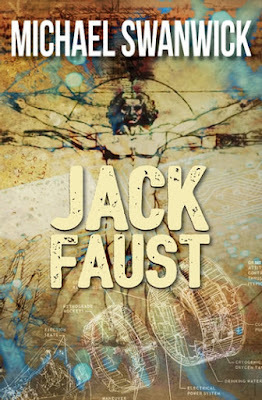
Open Road Media, which publishes several e-book novels of mine and one e-collection, has announced a one-day sale of Jack Faust for only $1.99.
That's tomorrow, Friday, April 29 and this deal is available in the US only. And just for the one day.
So if you're an e-book reader who doesn't have this title, wants to read it, and can afford to drop two bucks... well, then this deal is for you.
And it occurs to me . . .
It's possible that you don't know much about Jack Faust. Well... I could tell you that it's my revisionist science fiction retelling of the Faust legend. I could tell you that when I first read Christopher Marlowe's Dr. Faustus, I loved and was terrified by the opening and ending of the play as only a Catholic schoolboy could be, but regretted the middle acts where Faustus piddles away all that soul-bought power playing pranks on college students and the Pope. I wanted a Faust that was damned by the very knowledge he had lusted after. I could tell you that decades passed before I was a good enough writer to create that story.
But instead, I'll simply tell you that the demon Faust sells its soul to is actual an alien race in a parallel universe with a far higher ambient level of energy that wishes to destroy humanity and that its name is expressed in our universe as an equation:
me h = i δ t0 Φ H L Σ S
@font-face {font-family:"Cambria Math"; panose-1:2 4 5 3 5 4 6 3 2 4; mso-font-charset:0; mso-generic-font-family:roman; mso-font-pitch:variable; mso-font-signature:-536870145 1107305727 0 0 415 0;}p.MsoNormal, li.MsoNormal, div.MsoNormal {mso-style-unhide:no; mso-style-qformat:yes; mso-style-parent:""; margin:0in; mso-pagination:none; mso-layout-grid-align:none; text-autospace:none; font-size:12.0pt; font-family:"Times New Roman",serif; mso-fareast-font-family:"Times New Roman";}.MsoChpDefault {mso-style-type:export-only; mso-default-props:yes; font-size:10.0pt; mso-ansi-font-size:10.0pt; mso-bidi-font-size:10.0pt;}.MsoPapDefault {mso-style-type:export-only;}div.WordSection1 {page:WordSection1;}
If that's not enough to whet your appetite, you may not want to read this book.
*
April 26, 2022
The Once and Future Rye, Part Last: Risen Like the Phoenix
.
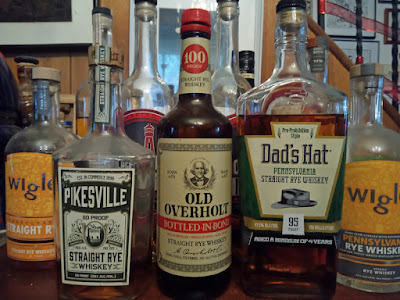
Chapter 11: Risen Like the Phoenix
Nature abhors a vacuum. In the early years of the twenty-first century, many entrepreneurs had made their nut by building a company from scratch and then selling it to whatever big fish of a corporation swallowed up their kind. Now they were looking around for a business that would be fun to build and run. Craft breweries were an obvious possibility, but that niche was already crowded and hard to make a name in. They did, however, serve as a good model for craft distilleries.
Ambitious men and women bought cheap real estate, expensive stills, and a lot of oak barrels, and set to work. Almost all began by making vodka and then gin, which required no aging. Then they set their sights higher… and saw that the market for rye was scandalously underserved.
Meanwhile, the Craft Cocktail movement was in full bloom. To oversimplify drastically, a lot of bartenders grew tired of mixing vodka with fruit juices and liqueurs to make sticky-sweet and obvious concoctions with names like Screaming Orgasm, Sex on the Beach, or Harvey Wallbanger. They wanted to regain their self-respect . Looking backward in time they rediscovered drinks that honored the alcohol in them. Drinks with names a grownup would feel comfortable ordering in public.
Not only did they succeed at all of the above, but by creating a market for sophisticated drinks, these heroic baristas resurrected extinct spirits like Old Tom Gin and liqueurs like Crème de Violette. If you’ve ever enjoyed a Martinez or an Aviation, you have reason to be grateful to them all.
The movement can be divided into two factions: One employs the finest and freshest ingredients to create classic cocktails, many of which had passed into near-oblivion. The other employs the finest and freshest ingredients to create new cocktails inspired by those classics but tweaked with combinations unknown to our revered ancestral topers. Which cult you prefer is strictly a personal choice. I choose to defer to whichever bar I happen to be in at the time.
To honor the completely mad crafters of artisanal cocktails, you could do worse than to raise a Perfect Black Manhattan, a variant of a drink invented in San Francisco in 2015 with dry vermouth replacing half the Averna to keep its flavor from overwhelming the rye:
Perfect Black Manhattan
2 ounces rye whiskey
½ ounce Averna
½ ounce dry vermouth
1 dash Angostura bitters
1 dash orange bitters
spiced cherry
directions: mix, chill, and serve with a spiced cherry for garnish
This is a beautifully dark cocktail with an appropriately bitter heart. It would be the perfect drink to mix to celebrate the end of an affair you should never have begun. Like life itself, it can be savored despite the bitterness and, on occasion, even because of it.
On which note, this chronicle comes—gracefully, I hope—to an end. It has been a long and bumpy road that led from the barely drinkable swill our Colonial forebears tossed back with depraved abandon to the artisanal and hand-crafted (whatever that may mean in this context) ryes and rye cocktails that now grace our better watering holes.
No matter what the coming decades may bring, it may be confidently predicted that they will pass in the twinkling of an eye. When they do, parts of this chronicle will doubtless seem quaint and, for reasons unforeseeable, out of date. So be it. But, barring the extinction of the human race, it seems a safe bet that rye whiskey will endure.
To which pleasant prospect, I raise my glass. Slainte!
*
@font-face {font-family:"Cambria Math"; panose-1:2 4 5 3 5 4 6 3 2 4; mso-font-charset:0; mso-generic-font-family:roman; mso-font-pitch:variable; mso-font-signature:-536870145 1107305727 0 0 415 0;}p.MsoNormal, li.MsoNormal, div.MsoNormal {mso-style-unhide:no; mso-style-qformat:yes; mso-style-parent:""; margin:0in; mso-pagination:none; mso-layout-grid-align:none; text-autospace:none; font-size:12.0pt; font-family:"Times New Roman",serif; mso-fareast-font-family:"Times New Roman";}p.MsoHeader, li.MsoHeader, div.MsoHeader {mso-style-priority:99; mso-style-unhide:no; mso-style-link:"Header Char"; margin:0in; mso-pagination:none; tab-stops:center 3.0in right 6.0in; mso-layout-grid-align:none; text-autospace:none; font-size:12.0pt; font-family:"Times New Roman",serif; mso-fareast-font-family:"Times New Roman";}span.MsoPageNumber {mso-style-priority:99; mso-style-unhide:no; font-family:"Times New Roman",serif; mso-bidi-font-family:"Times New Roman";}span.HeaderChar {mso-style-name:"Header Char"; mso-style-priority:99; mso-style-unhide:no; mso-style-locked:yes; mso-style-link:Header; mso-ansi-font-size:12.0pt; mso-bidi-font-size:12.0pt;}.MsoChpDefault {mso-style-type:export-only; mso-default-props:yes; font-size:10.0pt; mso-ansi-font-size:10.0pt; mso-bidi-font-size:10.0pt;}.MsoPapDefault {mso-style-type:export-only;}div.WordSection1 {page:WordSection1;}
April 20, 2022
The Iron Dragon's Mother -- In Russian
.
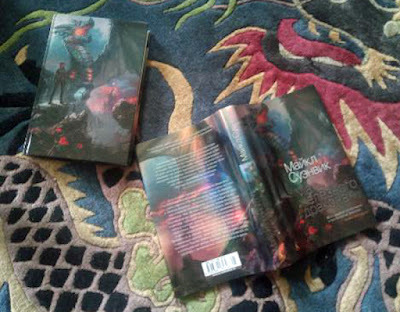
This is ironic and even a little sad. I've just received a copy of my latest Russian publication--The Iron Dragon's Mother in translation.
It's a beautifully made book. Above are the book itself and the foil cover using the same image. Azbooka does a lovely job of creating books that readers would want to own. If you could hold it, you'd know it has good heft. If you opened it, you would admire the paper. If you could read Russian... well, I have reason to believe the translator has done a good job.
Russian publishing has been very good to me. Russian fandom has been warm and supporting. The Russian writing community has welcomed me with open arms--even those writers who are the Russian equivalent of the patriotic American future-war writers that Baen Books has been so good at publishing and promoting. (Times being what they are, I will specify here that I admire Baen and approve of those books.) I have not a single bad thing to say about anybody I've met and/or associated with in Russia. I love those guys to pieces.
You can see the "but" coming here, can't you?
When Putin invaded Ukraine--you can hardly say that it was the Russia people when even the soldiers sent there had no idea what was going on--I resigned my position as honorary president of the International Writers Union. This enraged some of my Russian friends, who believe every word they hear on RT. I got an earful from them. They were 100% sincere.
However this war ends, I don't believe I will be welcome back in Russia for a long, long time. And, for my part, I won't be publishing my books there either.
So be it. As much as I love Russia and the Russian people, my loss is as nothing compared to what every single Ukrainian is going through now.
But looking at this lovely, lovely book... It's ironic and even a little sad.
The Once and Future Rye, Part 10: Indiana's Invisible Giant
.
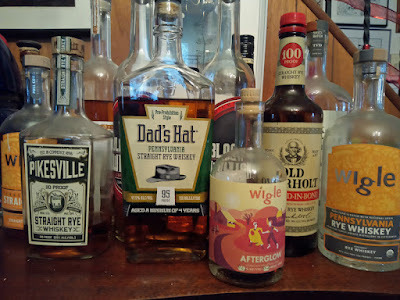
Chapter 10: Indiana’s Invisible Giant
The great scandal of rye whiskey, one that is periodically (and gleefully) exposed in articles and posts on the Web, is that many of the boutique ryes you like so much are not distilled on the picturesque farms or rehabbed factory buildings from which they are sold. Rather, they are bought from mega-distilleries in Indiana.
This is true and, for the most part, it doesn’t matter much.
Here’s the dirt.
Midwest Grain Products, almost universally known as MGP, is a megafactory distillery in Lawrenceburg, Indiana that produces rye and bourbon in bulk and sells it to over fifty different labels that bottle and resell it as their own, at prices that can make you wince. So that “craft distillery” you love so dearly may not even own a still.
That sounds scandalous and, indeed, when the word got out, there was a scandal. One famous distillery was found guilty of outright fraud in a court of law.
But.
MGP makes very good rye—as witness all the people paying sometimes premium prices for those fifty-plus brands. Also, they sell dozens of different mash bills, which the smaller distilleries often mix in different proportions. (Hence the references to “our own recipe” on a bottle that deftly sidesteps where the distilling takes place.) Nor is the production of whiskey over when it leaves Indiana. The rye is aged for different periods of time and often finished in barrels with varying histories behind them—sherry perhaps or even, to bring this history full-circle, rum. So the taste, as experienced samplers of rye whiskey know, really does differ from label to label.
One of my favorite ryes for everyday Manhattans was born in Indiana and finished and sold in the beach town of Cape May, New Jersey. Cape May is where Mom and Dad take the family to avoid seeing drunken antics and young women in thong bikinis. If a whiskey can survive that, you know it’s fundamentally sound.
To honor the fine craftspeople of the all but anonymous Indiana corporation that produces so many first-rate bourbons and rye whiskeys, a noble cocktail like the Boulevardier is only appropriate:
Boulevardier
2 ounces rye
1 ounce Campari
1 ounce sweet vermouth
orange peel
directions: combine ingredients, chill, and serve with an orange peel for garnish
The Boulevardier is a close relation of the Negroni with rye substituted for gin and increased in volume so the flavor of the rye won’t be swamped. Negronis are summer drinks, where Manhattans are best drunk in autumn and winter. So the Boulevardier makes a fine bridge between the seasons. Also, it is one tasty cocktail!
@font-face {font-family:"Cambria Math"; panose-1:2 4 5 3 5 4 6 3 2 4; mso-font-charset:0; mso-generic-font-family:roman; mso-font-pitch:variable; mso-font-signature:-536870145 1107305727 0 0 415 0;}p.MsoNormal, li.MsoNormal, div.MsoNormal {mso-style-unhide:no; mso-style-qformat:yes; mso-style-parent:""; margin:0in; mso-pagination:none; mso-layout-grid-align:none; text-autospace:none; font-size:12.0pt; font-family:"Times New Roman",serif; mso-fareast-font-family:"Times New Roman";}.MsoChpDefault {mso-style-type:export-only; mso-default-props:yes; font-size:10.0pt; mso-ansi-font-size:10.0pt; mso-bidi-font-size:10.0pt;}.MsoPapDefault {mso-style-type:export-only;}div.WordSection1 {page:WordSection1;} *
April 19, 2022
Flash Sale! Today Only! In the Drift e-Book $2.99
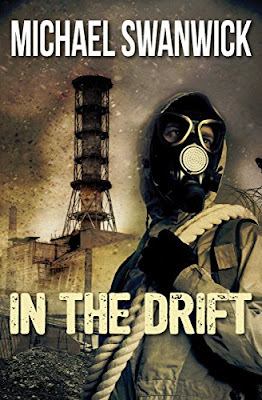
.
Open Road Media, which sells several of my ebooks, is offering In the Drift today only for $2.99, but only in the US.
These e-book sales come along pretty regularly. Which is good news for people who like e-books and hate spending lots of money. Here's what they sent me.
We are pleased to let you know that the following ebook(s) will be featured in price promotions soon.
Open Road will promote the feature via social media. We hope you can share the deal with your network as well. You can subscribe to the newsletters at the links below so that you will get the direct link to the deal on the day that it appears.
Newsletter Link Early Bird Books Subscribe Now The Lineup Subscribe Now The Portalist Subscribe Now Murder & Mayhem Subscribe Now A Love So True Subscribe Now The Archive Subscribe Now The ReaderSubscribe Now
April 17, 2022
Generic Advice for Writers
.
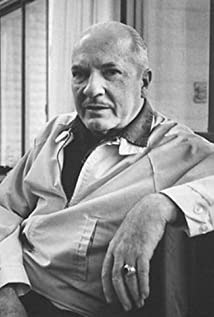
Recently, an aspirant writer IM'd me mentioning in seemingly-casual passing that he was trying hard to get published and "would love to hear your wisdom."
Well, okay. But I've spent so many hundreds of hours of my life giving Really Good and Insightful Advice to writers who then proceeded to effectively ignore it. Not willfully, but because they simply weren't ready to internalize and use it.
So I thought that if I placed my advice here and urged everyone who thinks it might be useful to share and disseminate it, there would be enough chance of somebody using it as a steppingstone to becoming a writer to make it worth my effort.
My advice comes in two parts. The first is Robert Heinlein's five rules for writers. He wrote this a lifetime ago and, though many have raised minor quibbles, not one writer in the decades since has tried to debunk it, so you know it's solid:
Rule One: You must write.
Rule Two: You must finish what you start.
Rule Three: You must refrain from rewriting, except to editorial order.
Rule Four: You must put it on the market.
Rule Five: You must keep it on the market until it has sold.
To this I would add three addenda:
Addendum One: Seek out writing advice from reliable sources. Give it a try. If it works, pat yourself on the back and put it in your toolbox. If it doesn't, discard it without a second thought. (There are many kinds of writers and no advice--except for most of Heinlein's--will work for all of them.)
Addendum Two: If you're writing a scene and you have trouble visualizing and describing it, you haven't done your research. Interview or visit. You'll end up with so much good stuff you'll be able to use only the most evocative.
Addendum Three: Write what you want to write, not what you think you should write. Somethingpunk is the hot new thing? Hundreds of writers are trying to pile on. You'll be lost in the wave of imitations. Your voice, your experience, your vision are what make you potentially a great writer. Follow them. Be a first-rate you, not a second-rate somebody else.
Um... and that's all, really. You can repay me by writing something I want to read.
*
April 12, 2022
The Once and Future Rye, Part 9: Bourbon After the Deluge
.
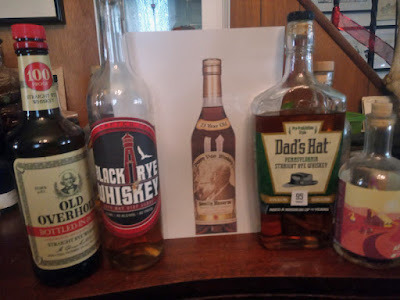
Chapter 9: Bourbon After the Deluge
Pretty much all histories of rye recount how, immediately after the Whiskey Rebellion, thousands of farmers left Pennsylvania for the wilds of Kentucky, bringing their stills with them. Where, the climate and soil being better suited for corn than for rye, they (it is implied) invented Bourbon.
Histories of bourbon, however, omit that narrative. In its place, they present the inconvenient fact that bourbon was invented beforethe Whiskey Rebellion. When the whiskey tax was imposed, Kentucky distillers wisely refrained from outright rebellion. Instead, they kept their heads down and simply didn’t pay it. After the uprising in Pennsylvania, nobody thought it prudent to try to make them do so.
It is perfectly understandable why, after its being eclipsed by bourbon, those who fancy rye would like to credit their favorite tipple for the birth of its rival. Nevertheless, bourbon has its own mystique, its own origin story, and its own folklore, the result of decades of hard work and corporate self-mythologizing. Bourbon is now—it has to be said, without blushing or looking away—America’s Whiskey.
This is not likely to change anytime soon. We can only be gracious in our recognition of the facts.
To graciously celebrate the ascension of bourbon to the heights once held by rye, there can be no better cocktail than the Mint Julep:
Mint Julep
5 to 8 mint leaves
¼ ounce simple syrup
2 ounces bourbon
mint sprig
directions: muddle mint leaves in simple syrup, add bourbon, then pack glass tightly with crushed ice; stir until the cup is frosted on the outside; top with more ice and garnish with mint sprig, making. Be sure to slap the sprig smartly on the back of your hand first to release the aromatic oils
The mint julep is served in a rocks glass or a silver julep cup and is traditionally prepared with a lot of fuss and ceremony. Let’s be honest here, that’s half the fun of it.
Above: Okay, I confess, I have no bourbon in the house. And, not being a bourbon drinker, a bottle of Pappy Van Winkle would be wasted on me. Still. When you're faking it, why not go with the best?
*
@font-face {font-family:"Cambria Math"; panose-1:2 4 5 3 5 4 6 3 2 4; mso-font-charset:0; mso-generic-font-family:roman; mso-font-pitch:variable; mso-font-signature:3 0 0 0 1 0;}@font-face {font-family:Calibri; panose-1:2 15 5 2 2 2 4 3 2 4; mso-font-charset:0; mso-generic-font-family:swiss; mso-font-pitch:variable; mso-font-signature:-536859905 -1073732485 9 0 511 0;}p.MsoNormal, li.MsoNormal, div.MsoNormal {mso-style-unhide:no; mso-style-qformat:yes; mso-style-parent:""; margin:0in; mso-pagination:widow-orphan; font-size:12.0pt; font-family:"Calibri",sans-serif; mso-ascii-font-family:Calibri; mso-ascii-theme-font:minor-latin; mso-fareast-font-family:Calibri; mso-fareast-theme-font:minor-latin; mso-hansi-font-family:Calibri; mso-hansi-theme-font:minor-latin; mso-bidi-font-family:"Times New Roman"; mso-bidi-theme-font:minor-bidi;}.MsoChpDefault {mso-style-type:export-only; mso-default-props:yes; font-family:"Calibri",sans-serif; mso-ascii-font-family:Calibri; mso-ascii-theme-font:minor-latin; mso-fareast-font-family:Calibri; mso-fareast-theme-font:minor-latin; mso-hansi-font-family:Calibri; mso-hansi-theme-font:minor-latin; mso-bidi-font-family:"Times New Roman"; mso-bidi-theme-font:minor-bidi;}div.WordSection1 {page:WordSection1;}
Yuri Night.
.

This is Yuri Night, an international celebration of humanity's achievements in space. It is named, of course, after Yuri Gagarin, who on April12, 1961 was the first man to orbit the Earth and thus the first human being in outer space.
Years ago, I took my Russian friend Alexei to the Smithsonian's Udvar-Hazy Center, which contains an astonishing collection of airplanes, spacecraft, and related materials. It has several MiG fighter jets, but almost nothing about the Soviet space program. "It's as if it never existed," Alexei murmured sadly.
Well, the problem was that the Udvar-Hazy displays only the most spectacular of objects and almost all of those associated with the Soviet Union remain in Russia. The USSR did many terrible things. But there's no denying this achievement.
Alexei can take comfort in that. Far into the future, when all else about our times is forgotten, that fact will remain.
And speaking of mixed heritage . . .
The Soviet space program was built and run by a man known to the outside world only as the Grozny Konstruktor, the Great Engineer. His name was Sergei Pavlovich Korolov. I visited his house in Moscow once. Based entirely on the information presented there, he seemed an admirable person. He treated the cosmonauts like son and had them over on Sundays for dinner and a film with him. He had a large library on very simple shelves which included American science fiction. The travel items--a clock, a shaving kit, and so on--were simple, functional, cheap.
When the Soviet Union started their space program and needed somebody to head it, they recalled him from Siberia, where he was imprisoned.
His crime? He had stolen government resources, his time, by engaging in experiments in rocketry.
Above: Yuri Gagarin had the right stuff. Acknowledging that in no way justifies the Russian invasion of Ukraine.
*
April 11, 2022
Why "Secret American Biolabs" in Ukraine is Nonsense
.
A Russian friend who passionately believes every word that Putin and RT tell him wrote to inform me that the invasion of Ukraine was an unavoidable response to Western aggression. Among the assertions he made was that there are "secret American biolabs" in Ukraine preparing weapons to be used against Russia.
As it happens, I know something about this subject. Let’s unpack that claim.
The history of biological warfare is a long and inglorious one. I’ll skip most of it and start with Unit 731, established by the Imperial Japanese Army in 1935 in occupied China. This was a covert biological warfare research unit organized and run by General Shiro Ishi which performed experiments on large numbers of unwilling human beings.
A full account of the horrors of Unit 731 would turn your stomach. Here’s a relatively mild one. Chinese captives were staked out in open fields and exposed to flea bombs at various distances. The fleas in those bombs were infected with the bubonic plague. After exposure, the subjects were taken back to the barracks/hospital and the progress of the disease monitored. An equal number of uninfected people were maintained as controls and also carefully monitored. After a set period of time, everyone—the infected and uninfected alike—were killed and new subjects brought in for the next round of testing.
Everybody knows about Dr. Joseph Mengele and that the scientific community rejected use of the data he collected. But his experiments were only marginally scientific and his findings were worthless. Dr. Ishi’s scientific technique was impeccable, and the result was the only substantive body of information in existence on the medical effects of biological warfare. Russia, the United States, and China all cut deals to get their hands on it. Ishi was never prosecuted for his war crimes. He died in Tokyo a respected and prosperous man.
So the first thing you must know is: Nobody’s hands are clean.
Now consider the differences between a biological weapons facility and a biological research lab. They are chiefly one of intent. I heard a presentation at a Chemical and Biological Weapons conference where the manufacturer of an anthrax vaccine explained that there were so many—I forget the number; let’s pretend it’s 32—steps to creating the vaccine and that the last one was killing the living anthrax bacteria.
This means you can present the contents of any biological research facility as proofs of insidious intent. The centrifuges, gas chromatographs, incubators, autoclaves, glove boxes, and moon suits can all look very scary if your only exposure to microbiology is television dramas.
That’s the second thing to know: This is an easy false claim to make.
For purposes of warfare, biological weapons have the virtue of being terrifying, but that’s about it. All the world considers their use a war crime. They also have the potential of backfiring on their users. Bacteria and viruses are no respecters of borders. Consider the ease with which the Covid-19 coronavirus roams from continent to continent.
Back when I was a lowly Clerk-Typist 2 in the Commonwealth of Pennsylvania Department of Health Bureau of Laboratories, I often heard speculation that smallpox—so far as is known, the virus that causes it exists only in two laboratories, one each in the United States and Russia—would make an excellent weapon. It’s fast, terrifying, debilitating, and highly contagious, and the aggressor nation could easily inoculate its own population against it. But as the last few years have shown, it’s not easy to convince everyoneto take the vaccine. Also, when the disease spreads to nations not involved in the conflict, whoever was responsible will find themselves extremely unpopular.
War is ugly. Spreading disease is easy. Treaties are often broken. Yet in the post-WWII era, with the exception of the Rajneeshee salmonella poisonings in 1984 Oregon, biowarfare and bioterrorism seem to be nonexistent.
By contrast, chemical weapons, also banned by international treaties, have been employed in various wars, military actions, and terrorist and anti-terrorist events in Yemen, Rhodesia, Angola, Thailand, Iran, Iraq, Kuwait, Syria, Tokyo, Russia, and elsewhere.
This is the third thing to know: Currently, biowarfare is nobody’s first choice.
There are four biosafety levels for biological laboratories from BSL-1 labs, which handle low risk microbes with little chance of infecting a healthy adult to BSL-4 labs, which work with highly dangerous microbes that are frequently fatal, and have no treatment or vaccine, such as the Ebola and Marburg viruses. (There are only a handful of BSL-4 laboratories in the world.) Each level has higher degree of security than the one before.
Any facility working to research or create bioweapons would have to be at least BSL-3, with special containment and air-handling requirements, and such laboratories take their security very seriously indeed. I know, because I once tried to gain access to one using deceit and human engineering and didn’t come close to succeeding. (It was an unannounced test arranged by my wife, Marianne Porter, who was in charge of laboratory evaluation. She wanted somebody who obviously didn’t belong there yet looked vaguely familiar. I fit the bill.) Most of the security, however, is directed inward, to confine the pathogens the laboratory works with: HEPA air filtration, negative air pressure, airlock-style doors, and on and on.
Even at that, accidents happen. The most notable of these was the accidental release of anthrax from a Soviet military research and/or bioweapon production facility in Sverdlovsk (now Ekaterinburg) in the Ural Mountains in 1979. The event killed at least 66 people and possibly a great many more.
This was a black eye for the Soviet Union which, like China and the US, was a signatory of the Biological Weapons Convention banning the development, production, acquisition, transfer, stockpiling and use of biological weapons, as is Russia today. All three nations will tell you that their research into bioweaponry is for defensive purposes only and this may well be true. Only those directly involved and possibly certain intelligence organizations know for sure.
Which is my fourth point: No country wants to be exposed as owning or using bioweaponry.
The immanence of war has a way of reshaping industry. At the beginning of World War Two, Stalin moved the USSR’s heavy industry deep into the Urals, where the factories building tanks and other armaments that helped win the war were out of Hitler’s reach. Not long after the war, China’s government, fearful that General MacArthur might have plans to invade their country, moved much of their manufacturing deep inland, away from the seacoast where it might easily be seized or destroyed.
My fifth and final point should be self-evident: Warlike nations do not put their weapons manufacturing facilities where their enemies might easily seize them.
Yet my Russian friend would have me believe that there are thirty—he was emphatic about that number—secret bioweapon laboratories scattered throughout Ukraine. This is an absurd claim and doubly so when one considers that American intelligence, no less than Putin himself, originally expected the Russian military to overrun Ukraine in a matter of days.
The secret biolabs charge is a highly emotional one, but it falls apart on examination.
Note: I resigned my position as honorary president of the International Union of Writers when Russia invaded Ukraine. Since then, I have several times requested that they take down my name from their website. Last week, I informed the organization’s officers that if my name was not taken down, the above essay might be received as an official statement of the IUW.
My name is still there.
@font-face {font-family:"Cambria Math"; panose-1:2 4 5 3 5 4 6 3 2 4; mso-font-charset:0; mso-generic-font-family:roman; mso-font-pitch:variable; mso-font-signature:3 0 0 0 1 0;}@font-face {font-family:Calibri; panose-1:2 15 5 2 2 2 4 3 2 4; mso-font-charset:0; mso-generic-font-family:swiss; mso-font-pitch:variable; mso-font-signature:-536859905 -1073732485 9 0 511 0;}p.MsoNormal, li.MsoNormal, div.MsoNormal {mso-style-unhide:no; mso-style-qformat:yes; mso-style-parent:""; margin:0in; mso-pagination:widow-orphan; font-size:12.0pt; font-family:"Calibri",sans-serif; mso-ascii-font-family:Calibri; mso-ascii-theme-font:minor-latin; mso-fareast-font-family:Calibri; mso-fareast-theme-font:minor-latin; mso-hansi-font-family:Calibri; mso-hansi-theme-font:minor-latin; mso-bidi-font-family:"Times New Roman"; mso-bidi-theme-font:minor-bidi;}.MsoChpDefault {mso-style-type:export-only; mso-default-props:yes; font-family:"Calibri",sans-serif; mso-ascii-font-family:Calibri; mso-ascii-theme-font:minor-latin; mso-fareast-font-family:Calibri; mso-fareast-theme-font:minor-latin; mso-hansi-font-family:Calibri; mso-hansi-theme-font:minor-latin; mso-bidi-font-family:"Times New Roman"; mso-bidi-theme-font:minor-bidi;}div.WordSection1 {page:WordSection1;}
*
@font-face {font-family:"Cambria Math"; panose-1:2 4 5 3 5 4 6 3 2 4; mso-font-charset:0; mso-generic-font-family:roman; mso-font-pitch:variable; mso-font-signature:3 0 0 0 1 0;}@font-face {font-family:Calibri; panose-1:2 15 5 2 2 2 4 3 2 4; mso-font-charset:0; mso-generic-font-family:swiss; mso-font-pitch:variable; mso-font-signature:-536859905 -1073732485 9 0 511 0;}p.MsoNormal, li.MsoNormal, div.MsoNormal {mso-style-unhide:no; mso-style-qformat:yes; mso-style-parent:""; margin:0in; mso-pagination:widow-orphan; font-size:12.0pt; font-family:"Calibri",sans-serif; mso-ascii-font-family:Calibri; mso-ascii-theme-font:minor-latin; mso-fareast-font-family:Calibri; mso-fareast-theme-font:minor-latin; mso-hansi-font-family:Calibri; mso-hansi-theme-font:minor-latin; mso-bidi-font-family:"Times New Roman"; mso-bidi-theme-font:minor-bidi;}.MsoChpDefault {mso-style-type:export-only; mso-default-props:yes; font-family:"Calibri",sans-serif; mso-ascii-font-family:Calibri; mso-ascii-theme-font:minor-latin; mso-fareast-font-family:Calibri; mso-fareast-theme-font:minor-latin; mso-hansi-font-family:Calibri; mso-hansi-theme-font:minor-latin; mso-bidi-font-family:"Times New Roman"; mso-bidi-theme-font:minor-bidi;}div.WordSection1 {page:WordSection1;}
Michael Swanwick's Blog
- Michael Swanwick's profile
- 546 followers



